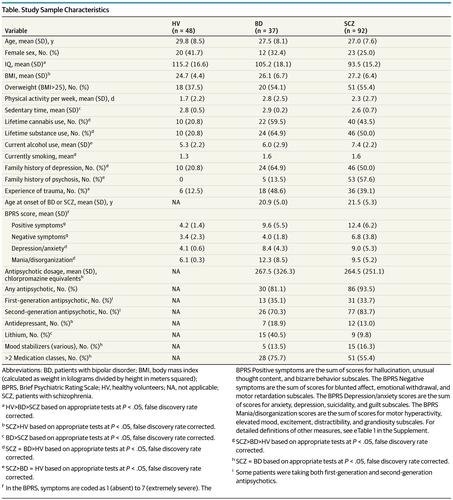JAMA Psychiatry ( IF 22.5 ) Pub Date : 2018-04-01 , DOI: 10.1001/jamapsychiatry.2017.4741 Dominik A Moser 1 , Gaelle E Doucet 1 , Won Hee Lee 1 , Alexander Rasgon 1 , Hannah Krinsky 1 , Evan Leibu 1 , Alex Ing 2 , Gunter Schumann 2 , Natalie Rasgon 3, 4 , Sophia Frangou 1

|
Importance Alterations in multiple neuroimaging phenotypes have been reported in psychotic disorders. However, neuroimaging measures can be influenced by factors that are not directly related to psychosis and may confound the interpretation of case-control differences. Therefore, a detailed characterization of the contribution of these factors to neuroimaging phenotypes in psychosis is warranted.
Objective To quantify the association between neuroimaging measures and behavioral, health, and demographic variables in psychosis using an integrated multivariate approach.
Design, Setting, and Participants This imaging study was conducted at a university research hospital from June 26, 2014, to March 9, 2017. High-resolution multimodal magnetic resonance imaging data were obtained from 100 patients with schizophrenia, 40 patients with bipolar disorder, and 50 healthy volunteers; computed were cortical thickness, subcortical volumes, white matter fractional anisotropy, task-related brain activation (during working memory and emotional recognition), and resting-state functional connectivity. Ascertained in all participants were nonimaging measures pertaining to clinical features, cognition, substance use, psychological trauma, physical activity, and body mass index. The association between imaging and nonimaging measures was modeled using sparse canonical correlation analysis with robust reliability testing.
Main Outcomes and Measures Multivariate patterns of the association between nonimaging and neuroimaging measures in patients with psychosis and healthy volunteers.
Results The analyses were performed in 92 patients with schizophrenia (23 female [25.0%]; mean [SD] age, 27.0 [7.6] years), 37 patients with bipolar disorder (12 female [32.4%]; mean [SD] age, 27.5 [8.1] years), and 48 healthy volunteers (20 female [41.7%]; mean [SD] age, 29.8 [8.5] years). The imaging and nonimaging data sets showed significant covariation (r = 0.63, P < .001), which was independent of diagnosis. Among the nonimaging variables examined, age (r = −0.53), IQ (r = 0.36), and body mass index (r = −0.25) were associated with multiple imaging phenotypes; cannabis use (r = 0.23) and other substance use (r = 0.33) were associated with subcortical volumes, and alcohol use was associated with white matter integrity (r = −0.15). Within the multivariate models, positive symptoms retained associations with the global neuroimaging (r = −0.13), the cortical thickness (r = −0.22), and the task-related activation variates (r = −0.18); negative symptoms were mostly associated with measures of subcortical volume (r = 0.23), and depression/anxiety was associated with measures of white matter integrity (r = 0.12).
Conclusions and Relevance Multivariate analyses provide a more accurate characterization of the association between brain alterations and psychosis because they enable the modeling of other key factors that influence neuroimaging phenotypes.
中文翻译:

精神病患者的行为,临床和多模式影像学表型之间的多元关联。
重要性 在精神病性疾病中已报道了多种神经影像学表现型的改变。但是,神经影像学测量可能会受到与精神病不直接相关的因素的影响,并且可能会混淆病例对照差异的解释。因此,有必要对这些因素对精神病神经影像学表型的贡献进行详细描述。
目的 使用综合多元方法量化精神病患者的神经影像学测量与行为,健康和人口统计学变量之间的关联。
设计,设置和参与者 这项影像学研究于2014年6月26日至2017年3月9日在一家大学研究医院进行。高分辨率的多模态磁共振成像数据来自100例精神分裂症患者,40例躁郁症患者和50例健康志愿者。计算的是皮层厚度,皮层下体积,白质分数各向异性,与任务相关的大脑激活(在工作记忆和情绪识别过程中)以及静止状态的功能连接性。在所有参与者中确定了与临床特征,认知,药物使用,心理创伤,身体活动和体重指数有关的非成像测量。成像和非成像测量之间的关联使用稀疏典范相关分析和鲁棒的可靠性测试进行建模。
主要结果和措施 精神病患者和健康志愿者的非影像和神经影像测量之间的关联的多变量模式。
结果 对92例精神分裂症患者(23名女性[25.0%];平均[SD]年龄,27.0 [7.6]岁),37例躁郁症患者(12名女性[32.4%];平均[SD]年龄, 27.5 [8.1]岁)和48名健康志愿者(20名女性[41.7%];平均[SD]年龄为29.8 [8.5]岁)。影像和非影像数据集显示出显着的协方差(r = 0.63,P <.001),这与诊断无关。在检查的非成像变量中,年龄(r = -0.53),智商(r = 0.36)和体重指数(r = -0.25)与多种成像表型相关。大麻使用(r = 0.23)和其他物质使用(r = 0.33)与皮层下体积相关,而饮酒与白质完整性相关(r = -0.15)。在多变量模型中,阳性症状与总体神经影像学(r = -0.13),皮层厚度(r = -0.22)以及与任务相关的激活变量(r = -0.18)保持关联。阴性症状主要与皮层下体积的测量有关(r = 0.23),抑郁/焦虑与白质完整性的测量有关(r = 0.12)。
结论与相关性 多变量分析可以更准确地描述大脑变化与精神病之间的关联,因为它们可以对影响神经影像学表现型的其他关键因素进行建模。











































 京公网安备 11010802027423号
京公网安备 11010802027423号